BLOG POSTS ARE PRELIMINARY MATERIALS CIRCULATED TO STIMULATE DISCUSSION AND CRITICAL COMMENT. THE VIEWS EXPRESSED ARE THOSE OF THE INDIVIDUAL AUTHORS. WHILE BLOG POSTS BENEFIT FROM ACTIVE UHERO DISCUSSION, THEY HAVE NOT UNDERGONE FORMAL ACADEMIC PEER REVIEW.
By Leah Bremer, Ahmed Elshall, Christopher Wada, Laura Brewington, Jade Delevaux, Aly El-Kadi, Clifford Voss, and Kimberly Burnett
Summary:
New research from the University of Hawaiʻi ʻIke Wai project indicates that current legal limits on withdrawals from the Puʻuloa (Pearl Harbor) aquifer, the primary water source for Oʻahu, are not sufficient to protect this important resource. Allowing excessive water withdrawals would make many of the wells in the aquifer unusable for public water supply. Too much withdrawal from the aquifer would also negatively impact culturally and ecologically important springs that feed places like the Sumida Watercress Farm, loʻi kalo systems, and coastal wetlands and nearshore ecosystems.
‘Ike Wai research also shows that the amount of water that can be safely withdrawn from the Puʻuloa aquifer in the future will be a lot less than is currently possible because climate change will likely reduce island rainfall, which supplies fresh water to the aquifer. Protecting mauka watersheds from high-water-use invasive species, which can further reduce groundwater recharge, is critical in the face of such change.
Nearly 99% of Hawaiʻi’s drinking water comes from water stored underground in aquifers across the islands. In addition to drinking water and other consumptive uses (like irrigation), this groundwater is vital for the health of streams, springs, and near shore ecosystems, which rely on fresh submarine groundwater discharge. Importantly for the economy and culture of Hawaiʻi, how water is managed profoundly affects the productivity and health of loʻi kalo (taro fields), loko iʻa (fish ponds), anchialine pools, wetlands, and nearshore coral reef ecosystems. Existing water management challenges and conflicts are projected to intensify with climate change, so setting up a framework for a sustainable water future under uncertain conditions is essential.
Fortunately, Hawaiʻi has among the most progressive water laws—the 1987 Hawaiʻi State Water Code—which has roots in Indigenous management principles and customary law and outlines the obligations of the Hawaiʻi State Commission on Water Resources Management (CWRM) to manage water for the benefit of the people of Hawaiʻi. Under this public trust doctrine, CWRM is obliged to protect these public trust uses in water management decisions: (1) the maintenance of waters in their natural state; (2) domestic water use of the general public, particularly drinking water; (3) the exercise of Native Hawaiian traditional and customary rights; and (4) reservations of water for Hawaiian Home Lands. The State Water Code also requires CWRM to establish sustainable yield (SY) limits for aquifers across the state, which is defined as: “the maximum rate at which water may be withdrawn from a water source without impairing the utility or quality of the water source as determined by the commission.”
It turns out that sustainable yield has been estimated for all aquifers using the lumped Robust Analytical Model 2. Unfortunately, there are a number of important challenges and conflicts surrounding these estimates. Among other things, RAM 2 is not spatially explicit, does not explicitly take into account public trust uses, and also does not account for climate and land-use change. There is currently interest by CWRM and others in revising SY estimates using more realistic modeling frameworks that protect water resources particularly in a context of a changing climate. A team of ʻIke Wai researchers from UHERO, WRRC, HIGP, and Pacific RISA set out to tackle this important water policy challenge in the Puʻuloa or Pearl Harbor aquifer (see Figure 1). We chose this aquifer because it provides two thirds of Oʻahu’s drinking water, and also supports numerous culturally and ecologically important springs, which have been rapidly declining since the rise of the plantation era in the mid 1800s. Historically this area was an important and abundant area of loʻi kalo, loko iʻa, and thriving nearshore systems. Today, the area is a mix of urban areas, military zones, agricultural lands (both active and fallow post-plantation), and conservation areas (with native forest in the higher elevation areas and non-native forest in the lower elevation areas, and expanding upward). While many of the springs have declined, there are still many important areas that rely on springs, including loʻi kalo systems, wetlands, and the Sumida watercress farm who we partnered with (see publication on this partnership).
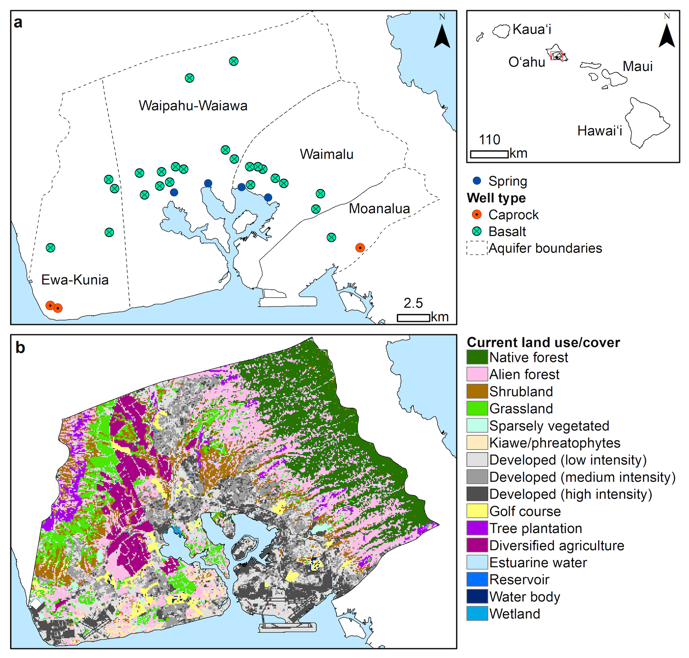
Using Puʻuloa as a case study, our team set up a groundwater optimization approach which combined an existing groundwater model with an optimization method to assess SY under varying future land use and climate scenarios and under a range of spring protection constraints (see Figure 2). In a first publication in Frontiers in Water, we demonstrate how SY changes based on degrees of restoring historical or maintaining current spring flow. Ultimately, deciding on the appropriate amount of spring flow vs. groundwater pumping is a societal decision, but it is critically important to ensure that public trust uses are protected in that process (see blog on this publication).
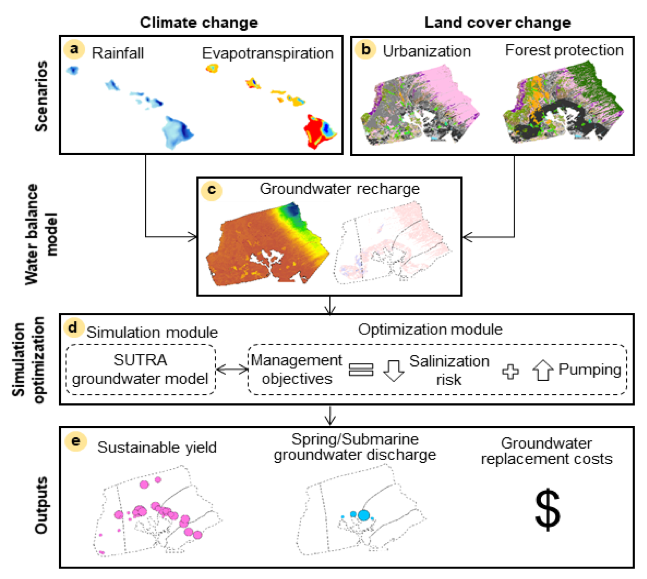
In a second, related study, recently published in Hydrogeology Journal, our team focused on understanding how future land use and climate change might change groundwater recharge, and how, this in turn would influence water management decisions. For climate change we used Representative Concentration Pathway (RCP) 8.5 mid-century, a relatively dry, but increasingly seen as likely future climate scenario. Running this scenario, we found that both groundwater recharge and SY would decrease by 16% (see Figure 3).
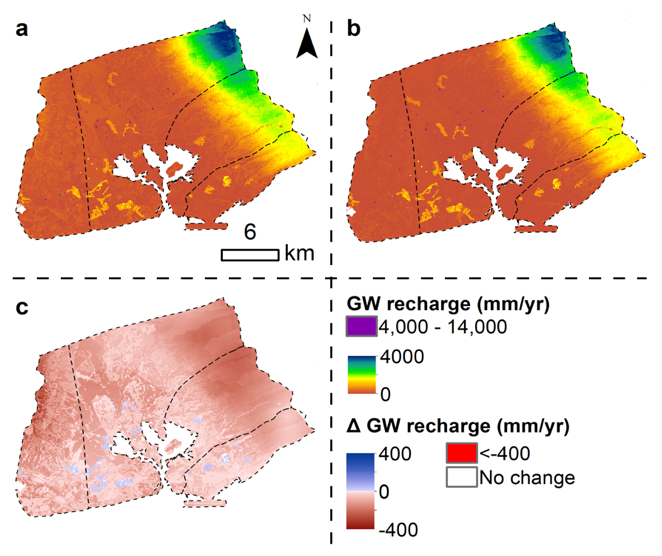
To evaluate what land use might look like in the future, we worked with the State Department of Forestry and Wildlife, the Koʻolau Watershed Partnership, the City and County of Honolulu, and the State of Hawaiʻi Department of Planning to come up with a set of possible futures of conservation, urban, and agricultural land (see Figure 4). For urban lands, we considered: 1) a corridor or dense development scenario where new development would be focused around a 1-km corridor around the future rail system and all agricultural land would be protected; vs 2) a sprawl development scenario where all agricultural lands (except areas designated as important agricultural lands) are developed. For watershed areas, we considered: 1) full protection of native forest; 2) targeted protection of native forest in planned and existing fenced areas; and 3) no protection of native forest.
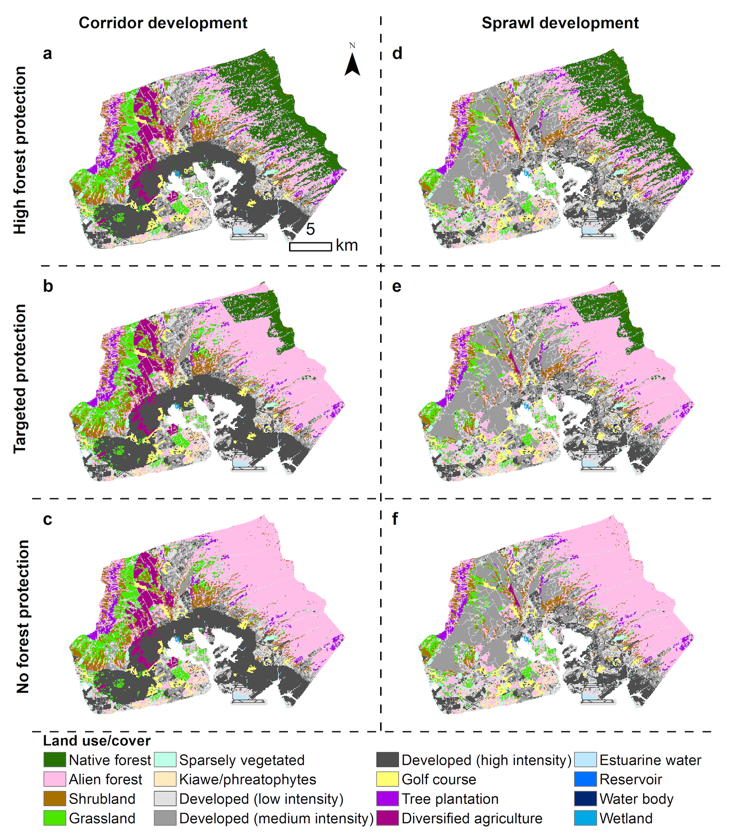
We find that protecting all of the native forest in Puʻuloa from high water-use invasive species, could prevent an additional loss 7-11% or 12-15 MGD of recharge compared to a no conservation scenario. In contrast, the type of urban development only changed recharge by about 1%. Running this through the groundwater optimization framework, we find that watershed protection can increase sustainable yield by 8-12 MGD, which translates into $26-40 million in annual savings in water supply costs after 50 years. The dollar benefit is based on the costs of supplying water over time as it increasingly becomes scarce, including when we will need to shift to desalination, which is very costly. We also find that the benefit of watershed protection varies spatially, with the greatest benefits in the Waipahu-Waiawa and Waimalu subaquifers (see Figure 5).
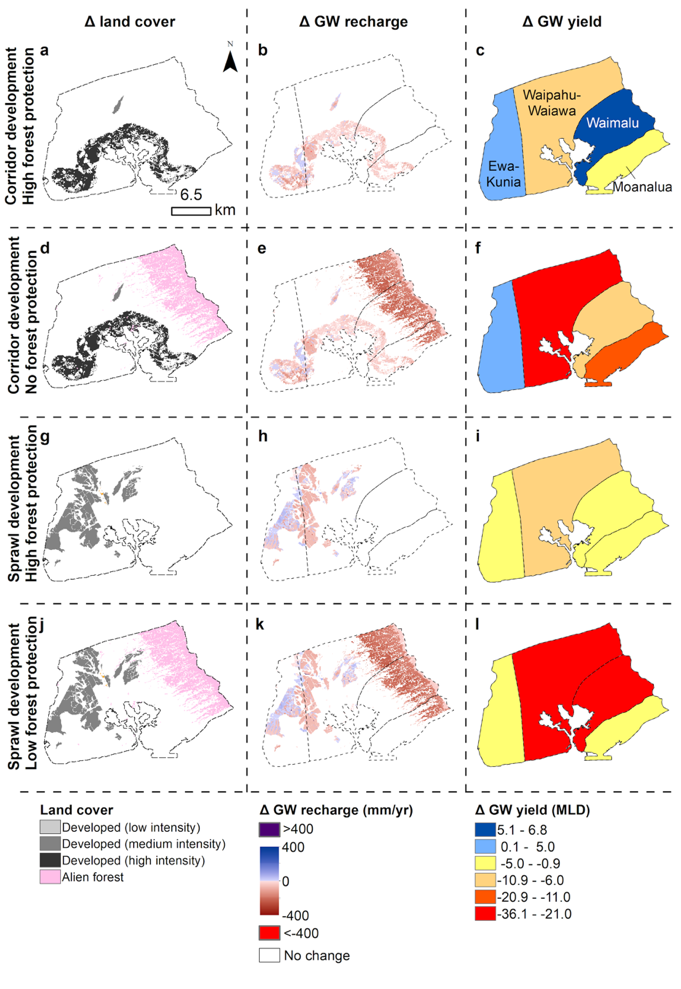
Finally, an important finding of our study is that current SY estimates for Puʻuloa (based on the RAM 2 model) at 182 MGD is likely a large over-estimate and should be revisited. Even without considering climate and land-use change, using our spatially explicit model, we estimate sustainable yield at 151 MGD, which is projected to decrease to 113 MGD, a full 38% less than current estimates even without considering land use change or the need to further reduce pumping to protect springs as demonstrated in our first study.
Collectively this research suggests a need to revisit sustainable yield in the Puʻuloa and other aquifers across the State to ensure the protection of water for the multiple ways that people use and value this resource in a context of changing land use and climate. It also suggests that native forest protection can play an important role in reducing the combined impacts of land-use and climate change on groundwater resources. However, more data on the ecohydrology of forests are needed to further refine this estimate.